Titanium Nitride as an Alternative Plasmonic Material for Plasmonic Enhancement in Organic Photovoltaics
Abstract
1. Introduction
2. Materials and Methods
2.1. Plasmonic Array Fabrication
2.2. Plasmon Enhanced Organic Photovoltaic Fabrication
2.3. Thin-Film and OPV Characterization
3. Results and Discussion
4. Conclusions
Author Contributions
Funding
Data Availability Statement
Acknowledgments
Conflicts of Interest
References
- Rhodes, C.J. Solar Energy: Principles and Possibilities. Sci. Prog. 2010, 93, 37–112. [Google Scholar] [CrossRef] [PubMed]
- Green, M.A. Solar Cells: Operating Principles, Technology, and System Applications; Prentice Hall: Hoboken, NJ, USA, 1982. [Google Scholar]
- Feng, N.N.; Michel, J.; Zeng, L.; Liu, J.; Hong, C.Y.; Kimerling, L.C.; Duan, X. Design of Highly Efficient Light-Trapping Structures for Thin-Film Crystalline Silicon Solar Cells. IEEE Trans. Electron. Devices 2007, 54, 1926–1933. [Google Scholar] [CrossRef]
- Yablonovitch, E.; Cody, G.D. Intensity Enhancement in Textured Optical Sheets for Solar Cells. IEEE Trans. Electron. Devices 1982, 29, 300–305. [Google Scholar] [CrossRef]
- Yablonovitch, E. Statistical Ray Optics. J. Opt. Soc. Am. 1982, 72, 899–907. [Google Scholar] [CrossRef]
- Catchpole, K.; Polman, A.; Müller, J.; Rech, B.; Springer, J.; Vanecek, M. Plasmonic Solar Cells. Optics Express 2008, 16, 21793–21800. [Google Scholar] [CrossRef]
- Atwater, H.A.; Polman, A. Plasmonics for Improved Photovoltaic Devices. Mater. Sustain. Energy 2010, 1–11. [Google Scholar] [CrossRef]
- Pillai, S.; Green, M.A. Plasmonics for Photovoltaic Applications. Sol. Energy Mater. Sol. Cells 2010, 94, 1481–1486. [Google Scholar] [CrossRef]
- Jang, Y.H.; Jang, Y.J.; Kim, S.; Quan, L.N.; Chung, K.; Kim, D.H. Plasmonic Solar Cells: From Rational Design to Mechanism Overview. Chem. Rev. 2016, 116, 14982–15034. [Google Scholar] [CrossRef]
- Polman, A. Applied Physics: Plasmonics Applied. Science 2008, 322, 868–869. [Google Scholar] [CrossRef]
- Enrichi, F.; Quandt, A.; Righini, G.C. Plasmonic Enhanced Solar Cells: Summary of Possible Strategies and Recent Results. Renew. Sustain. Energy Rev. 2018, 82, 2433–2439. [Google Scholar] [CrossRef]
- Kurt, H. Plasmonic Enhancement in PTB7-Th:PC71BM Organic Photovoltaics. Opt. Mater. 2022, 133, 113006. [Google Scholar] [CrossRef]
- Yang, J.; You, J.; Chen, C.-C.; Hsu, W.-C.; Tan, H.; Zhang, X.W.; Hong, Z.; Yang, Y. Plasmonic Polymer Tandem Solar Cell. ACS Nano 2011, 5, 6210–6217. [Google Scholar] [CrossRef] [PubMed]
- Jung, K.; Song, H.-J.; Lee, G.; Ko, Y.; Ahn, K.; Choi, H.; Kim, J.Y.; Ha, K.; Song, J.; Lee, J.-K.; et al. Plasmonic Organic Solar Cells Employing Nanobump Assembly via Aerosol-Derived Nanoparticles. ACS Nano 2014, 8, 2590–2601. [Google Scholar] [CrossRef] [PubMed]
- Khabbaz Abkenar, S.; Tufani, A.; Ozaydin Ince, G.; Kurt, H.; Turak, A.; Ow-Yang, C.W. Transfer Printing Gold Nanoparticle Arrays by Tuning the Surface Hydrophilicity of Thermo-Responsive Poly N-Isopropylacrylamide (PNIPAAm). Nanoscale 2017, 9, 2969–2973. [Google Scholar] [CrossRef] [PubMed]
- Liu, S.; Sun, Y.; Chen, L.; Zhang, Q.; Li, X.; Shuai, J. A Review on Plasmonic Nanostructures for Efficiency Enhancement of Organic Solar Cells. Mater. Today Phys. 2022, 24, 100680. [Google Scholar] [CrossRef]
- Gangadharan, D.T.; Xu, Z.; Liu, Y.; Izquierdo, R.; Ma, D. Recent Advancements in Plasmon-Enhanced Promising Third-Generation Solar Cells. Nanophotonics 2017, 6, 153–175. [Google Scholar] [CrossRef]
- Mandal, P. Application of Plasmonics in Solar Cell Efficiency Improvement: A Brief Review on Recent Progress. Plasmonics 2022, 17, 1247–1267. [Google Scholar] [CrossRef]
- Ai, B.; Fan, Z.; Wong, Z.J. Plasmonic–Perovskite Solar Cells, Light Emitters, and Sensors. Microsyst. Nanoeng. 2022, 8, 5. [Google Scholar] [CrossRef]
- Li, W.; Guler, U.; Kinsey, N.; Naik, G.V.; Boltasseva, A.; Guan, J.; Shalaev, V.M.; Kildishev, A.V. Refractory Plasmonics with Titanium Nitride: Broadband Metamaterial Absorber. Adv. Mater. 2014, 26, 7959–7965. [Google Scholar] [CrossRef]
- Catchpole, K.R.; Polman, A. Design Principles for Particle Plasmon Enhanced Solar Cells. Appl. Phys. Lett. 2008, 93, 191113. [Google Scholar] [CrossRef]
- Amalathas, A.P.; Alkaisi, M.M. Nanostructures for Light Trapping in Thin Film Solar Cells. Micromachines 2019, 10, 619. [Google Scholar] [CrossRef] [PubMed]
- Naik, G.V.; Shalaev, V.M.; Boltasseva, A.; Naik, G.V.; Shalaev, V.M.; Boltasseva, A. Alternative Plasmonic Materials: Beyond Gold and Silver. Adv. Mater. 2013, 25, 3264–3294. [Google Scholar] [CrossRef] [PubMed]
- Naik, G.V.; Kim, J.; Boltasseva, A. Oxides and Nitrides as Alternative Plasmonic Materials in the Optical Range. Opt. Mater. Express 2011, 1, 1090–1099. [Google Scholar] [CrossRef]
- Guler, U.; Naik, G.V.; Boltasseva, A.; Shalaev, V.M.; Kildishev, A.V. Performance Analysis of Nitride Alternative Plasmonic Materials for Localized Surface Plasmon Applications. Appl. Phys. B 2012, 107, 285–291. [Google Scholar] [CrossRef]
- Mahajan, U.; Dhonde, M.; Sahu, K.; Ghosh, P.; Shirage, P.M. Titanium Nitride (TiN) as a Promising Alternative to Plasmonic Metals: A Comprehensive Review of Synthesis and Applications. Mater. Adv. 2024, 5, 846–895. [Google Scholar] [CrossRef]
- Guler, U.; Shalaev, V.M.; Boltasseva, A. Nanoparticle Plasmonics: Going Practical with Transition Metal Nitrides. Mater. Today 2015, 18, 227–237. [Google Scholar] [CrossRef]
- Guler, U.; Boltasseva, A.; Shalaev, V.M. Refractory Plasmonics. Science 2014, 344, 263–264. [Google Scholar] [CrossRef]
- Günaydın, B.N.; Gülmez, M.; Torabfam, M.; Pehlivan, Z.S.; Tütüncüoğlu, A.; Kayalan, C.I.; Saatçioğlu, E.; Bayazıt, M.K.; Yüce, M.; Kurt, H. Plasmonic Titanium Nitride Nanohole Arrays for Refractometric Sensing. ACS Appl. Nano Mater. 2023, 6, 20612–20622. [Google Scholar] [CrossRef]
- Günaydın, B.N.; Hız, D.; Cankurtaran, S.E.; Gülmez, M.; Yüce, M.; Kurt, H. Plasmonic (Ti/Hf)N vs. Au Nanodisk Arrays: A Comparative Study of Refractometric Sensitivity. Opt. Sens. Detect. VIII 2024, 12999, 129990R. [Google Scholar]
- Park, D.G.; Cha, T.H.; Lim, K.Y.; Cho, H.J.; Kim, T.K.; Jang, S.A.; Suh, Y.S.; Misra, V.; Yeo, I.S.; Roh, J.S.; et al. Robust Ternary Metal Gate Electrodes for Dual Gate CMOS Devices. In Proceedings of the International Electron Devices Meeting. Technical Digest (Cat. No.01CH37224), Washington, DC, USA, 2–5 December 2001; pp. 671–674. [Google Scholar] [CrossRef]
- Reiter, S.; Han, W.; Mai, C.; Spirito, D.; Jose, J.; Zöllner, M.; Fursenko, O.; Schubert, M.A.; Stemmler, I.; Wenger, C.; et al. Titanium Nitride Plasmonic Nanohole Arrays for CMOS-Compatible Integrated Refractive Index Sensing: Influence of Layer Thickness on Optical Properties. Plasmonics 2023, 18, 831–843. [Google Scholar] [CrossRef]
- Askes, S.H.C.; Schilder, N.J.; Zoethout, E.; Polman, A.; Garnett, E.C. Tunable Plasmonic HfN Nanoparticles and Arrays. Nanoscale 2019, 11, 20252–20260. [Google Scholar] [CrossRef] [PubMed]
- Braic, L.; Vasilantonakis, N.; Mihai, A.; Villar Garcia, I.J.; Fearn, S.; Zou, B.; Alford, N.M.N.; Doiron, B.; Oulton, R.F.; Maier, S.A.; et al. Titanium Oxynitride Thin Films with Tunable Double Epsilon-Near-Zero Behavior for Nanophotonic Applications. ACS Appl. Mater. Interfaces 2017, 9, 29857–29862. [Google Scholar] [CrossRef] [PubMed]
- Kurt, H.; Pishva, P.; Pehlivan, Z.S.; Arsoy, E.G.; Saleem, Q.; Bayazıt, M.K.; Yüce, M. Nanoplasmonic Biosensors: Theory, Structure, Design, and Review of Recent Applications. Anal. Chim. Acta 2021, 1185, 338842. [Google Scholar] [CrossRef] [PubMed]
- Patsalas, P.; Kalfagiannis, N.; Kassavetis, S.; Abadias, G.; Bellas, D.V.; Lekka, C.; Lidorikis, E. Conductive Nitrides: Growth Principles, Optical and Electronic Properties, and Their Perspectives in Photonics and Plasmonics. Mater. Sci. Eng. R Rep. 2018, 123, 1–55. [Google Scholar] [CrossRef]
- Khalifa, A.E.; Swillam, M.A. Plasmonic Silicon Solar Cells Using Titanium Nitride: A Comparative Study. J. Nanophotonics 2014, 8, 084098. [Google Scholar] [CrossRef]
- Venugopal, N.; Gerasimov, V.S.; Ershov, A.E.; Karpov, S.V.; Polyutov, S.P. Titanium Nitride as Light Trapping Plasmonic Material in Silicon Solar Cell. Opt. Mater. 2017, 72, 397–402. [Google Scholar] [CrossRef]
- Khezripour, Z.; Mahani, F.F.; Mokhtari, A. Performance Improvement of Ultrathin Organic Solar Cells Utilizing Light-Trapping Aluminum-Titanium Nitride Nanosquare Arrays. Opt. Mater. 2018, 84, 651–657. [Google Scholar] [CrossRef]
- Khezripour, Z.; Mahani, F.F.; Mokhtari, A. Performance Improvement of Thin-Film Silicon Solar Cells Using Transversal and Longitudinal Titanium Nitride Plasmonic Nanogratings. Opt. Mater. 2020, 99, 109532. [Google Scholar] [CrossRef]
- Akhtary, N.; Zubair, A. Titanium Nitride Based Plasmonic Nanoparticles for Photovoltaic Application. Opt. Contin. 2023, 2, 1701–1715. [Google Scholar] [CrossRef]
- Kurt, H.; Alpaslan, E.; Yildiz, B.; Taralp, A.; Ow-Yang, C.W. Conformation-Mediated Förster Resonance Energy Transfer (FRET) in Blue-Emitting Polyvinylpyrrolidone (PVP)-Passivated Zinc Oxide (ZnO) Nanoparticles. J. Colloid. Interface Sci. 2017, 488, 348–355. [Google Scholar] [CrossRef]
- Kurt, H. Field-Dependent Charge Collection Model for Thin Film Organic Photovoltaics. Türk Doğa Fen Derg. 2020, 9, 135–140. [Google Scholar] [CrossRef]
- Kurt, H.; Ow-Yang, C.W. Impedance Spectroscopy Analysis of the Photophysical Dynamics Due to the Nanostructuring of Anode Interlayers in Organic Photovoltaics. Phys. Status Solidi (a) 2016, 213, 3165–3177. [Google Scholar] [CrossRef]
- Kurt, H.; Jia, J.; Shigesato, Y.; Ow-Yang, C.W. Tuning Hole Charge Collection Efficiency in Polymer Photovoltaics by Optimizing the Work Function of Indium Tin Oxide Electrodes with Solution-Processed LiF Nanoparticles. J. Mater.Sci. Mater. Electron. 2015, 26, 9205–9212. [Google Scholar] [CrossRef]
- Li, J.; Ye, J.; Chen, C.; Li, Y.; Verellen, N.; Moshchalkov, V.V.; Lagae, L.; Van Dorpe, P. Revisiting the Surface Sensitivity of Nanoplasmonic Biosensors. ACS Photonics 2015, 2, 425–431. [Google Scholar] [CrossRef]
- Nieborek, M.; Jastrzębski, C.; Płociński, T.; Wróbel, P.; Seweryn, A.; Judek, J. Optimization of the Plasmonic Properties of Titanium Nitride Films Sputtered at Room Temperature through Microstructure and Thickness Control. Sci. Rep. 2024, 14, 5762. [Google Scholar] [CrossRef]
- Haes, A.J.; Haynes, C.L.; McFarland, A.D.; Schatz, G.C.; Van Duyne, R.P.; Zou, S. Plasmonic Materials for Surface-Enhanced Sensing and Spectroscopy. MRS Bull. 2005, 30, 368–375. [Google Scholar] [CrossRef]
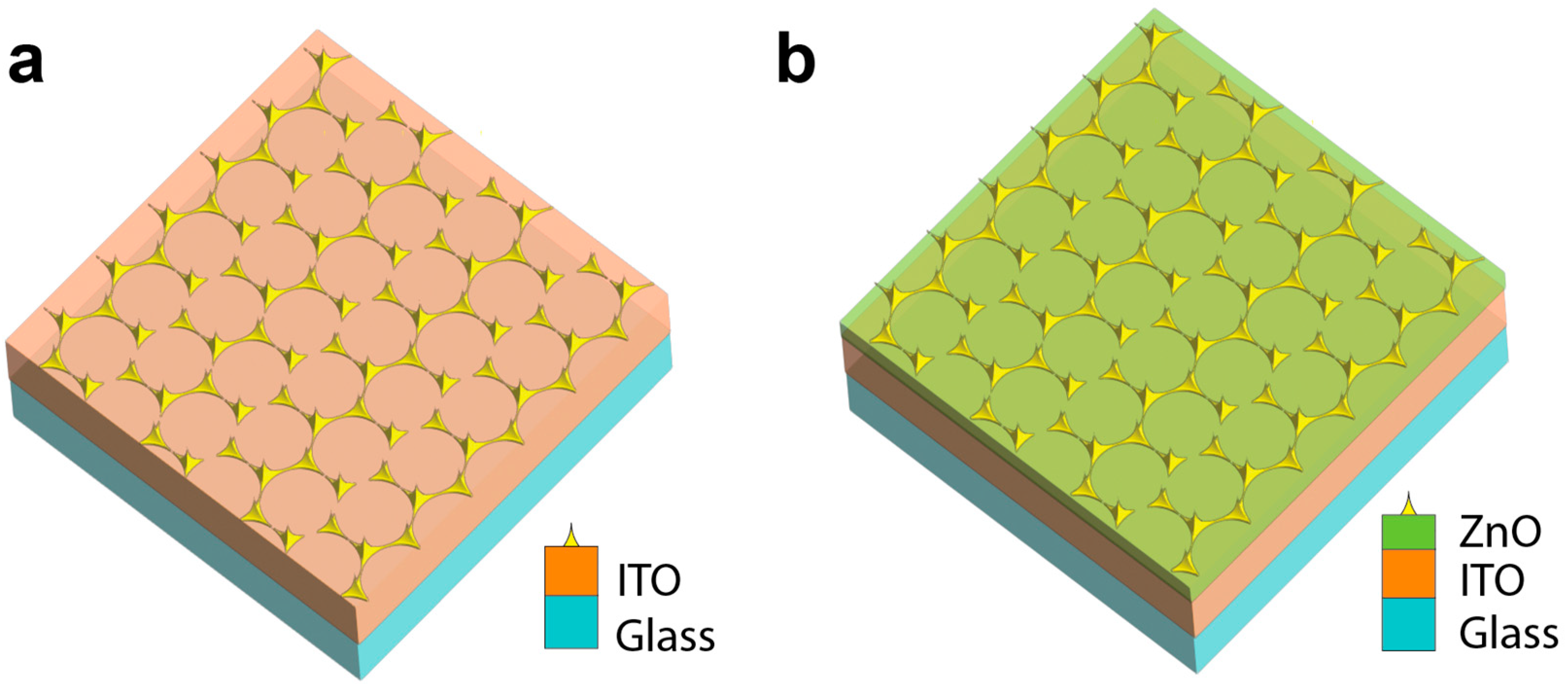
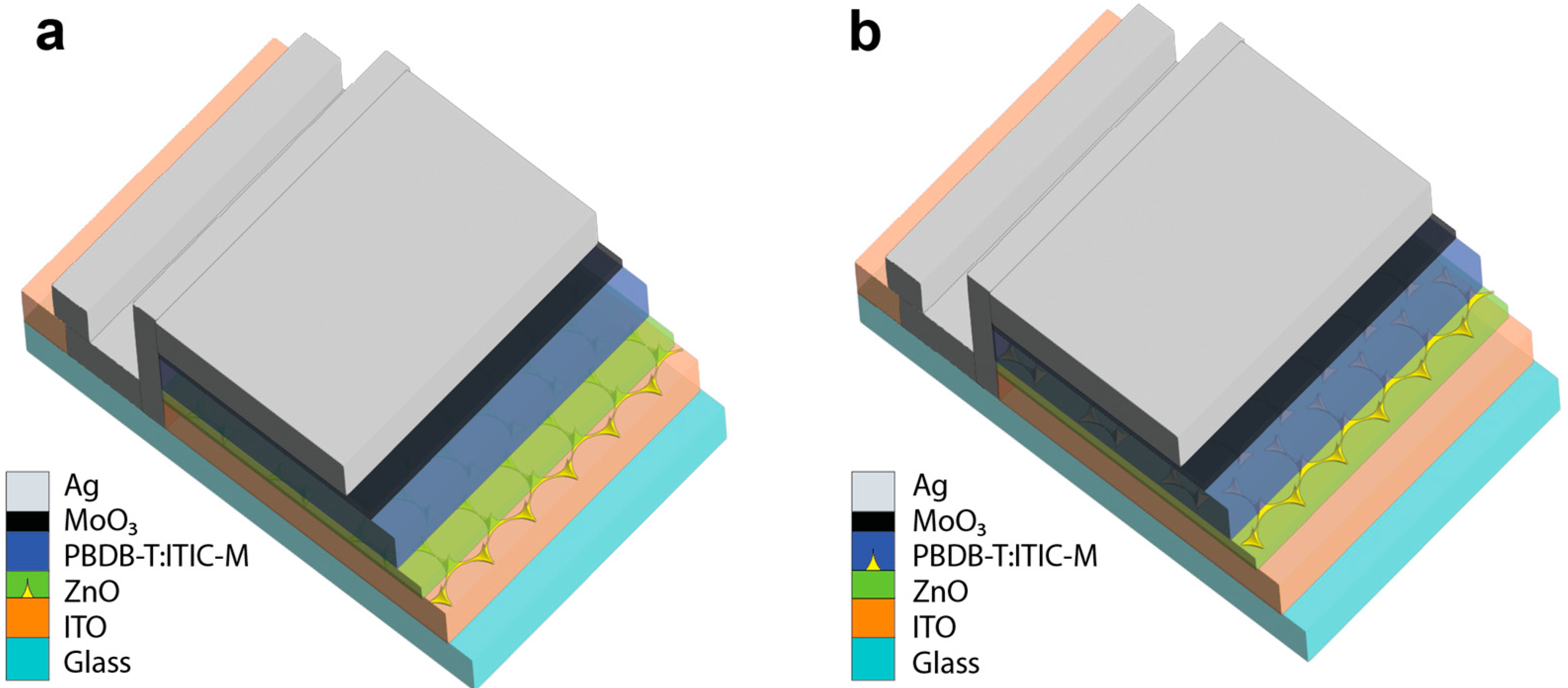

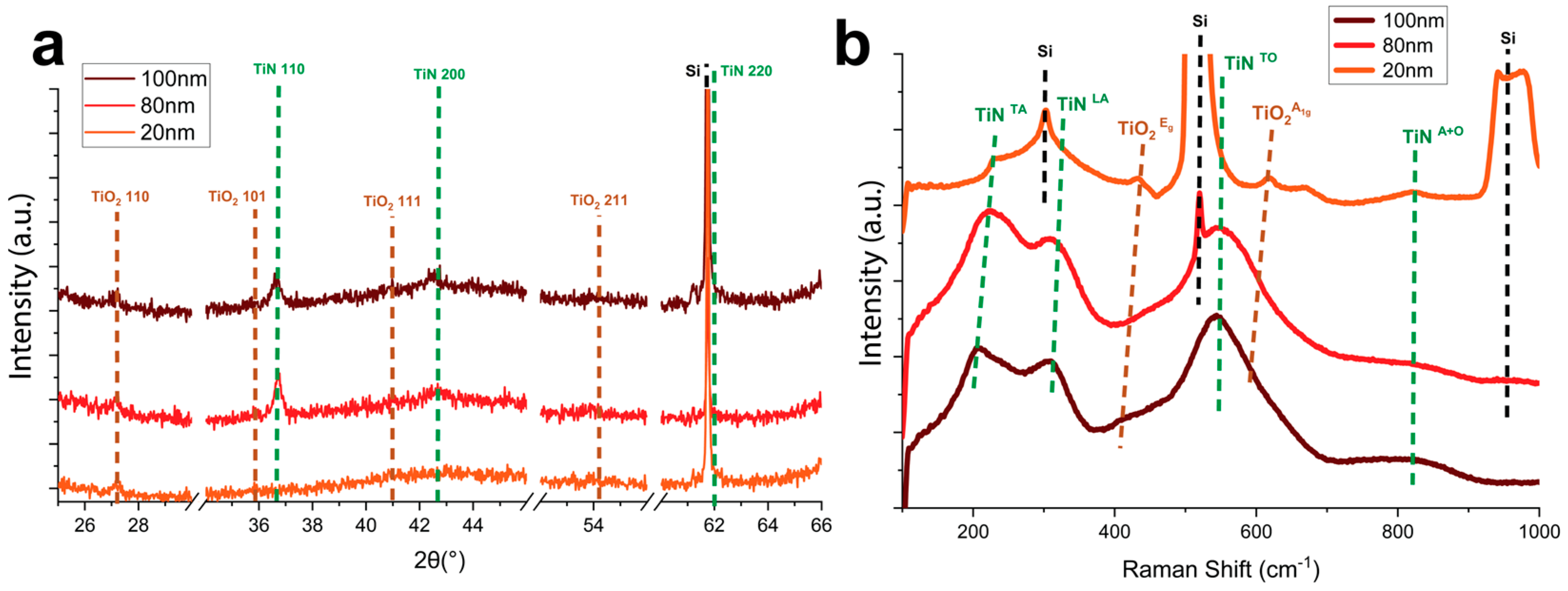
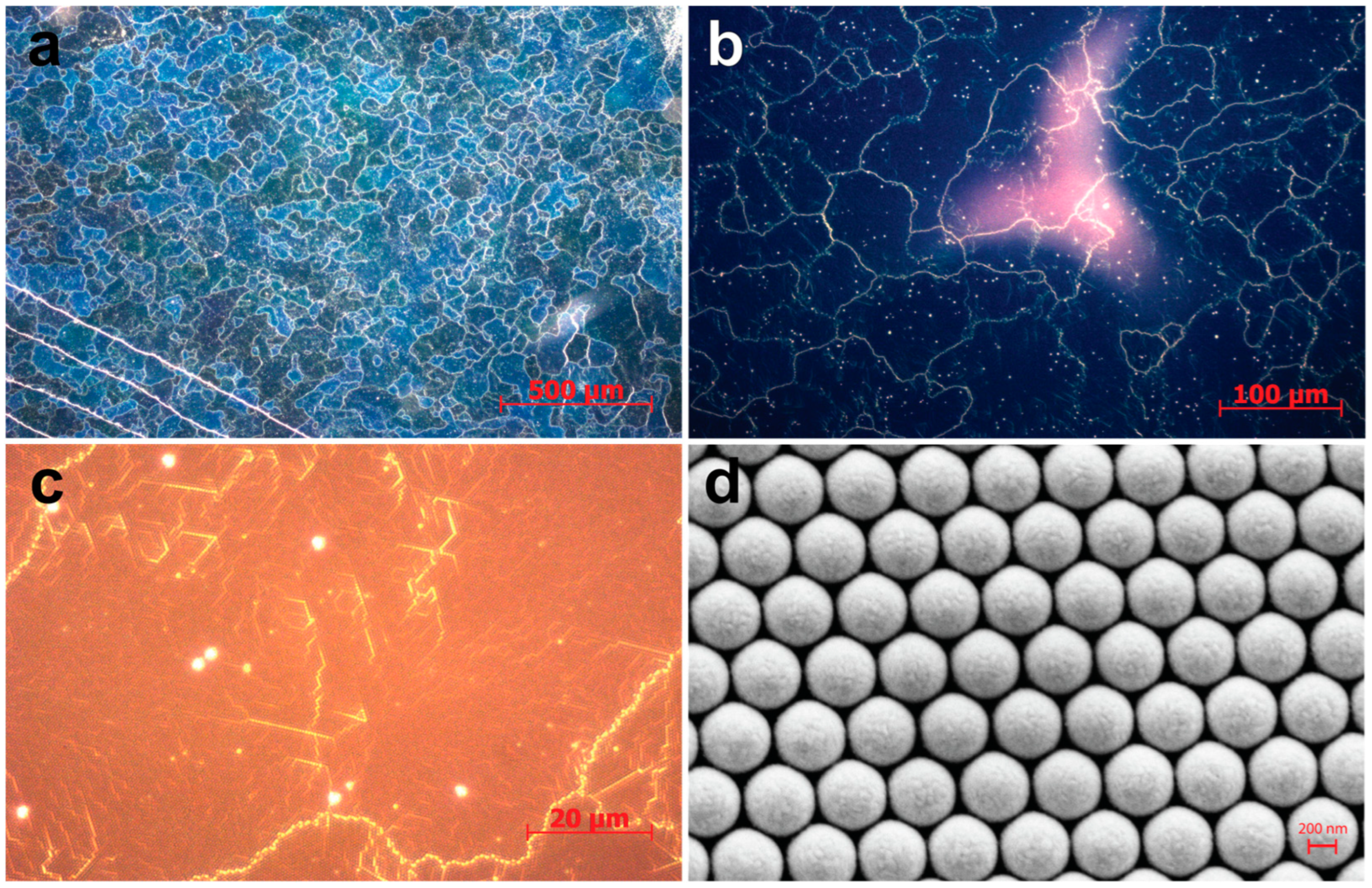

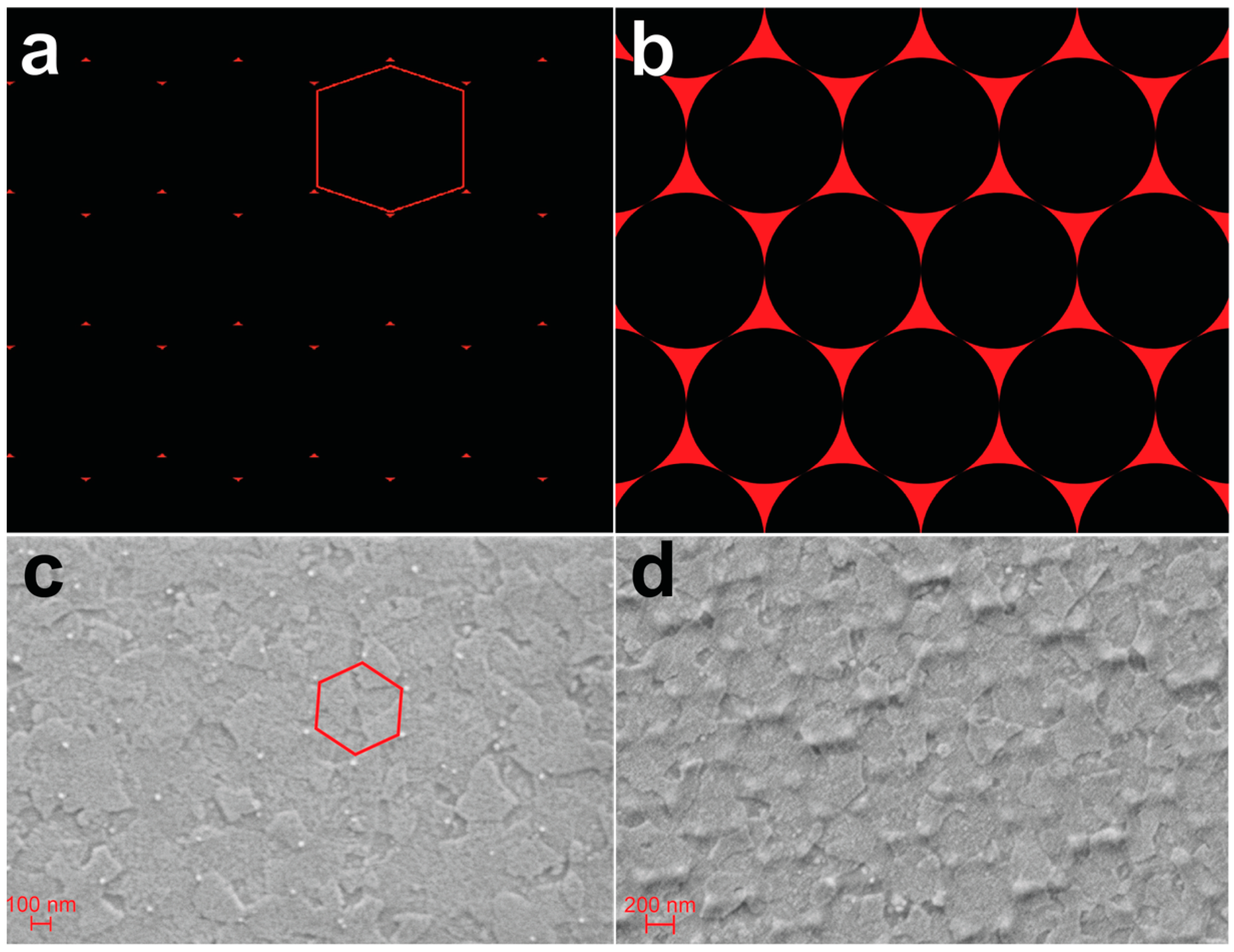



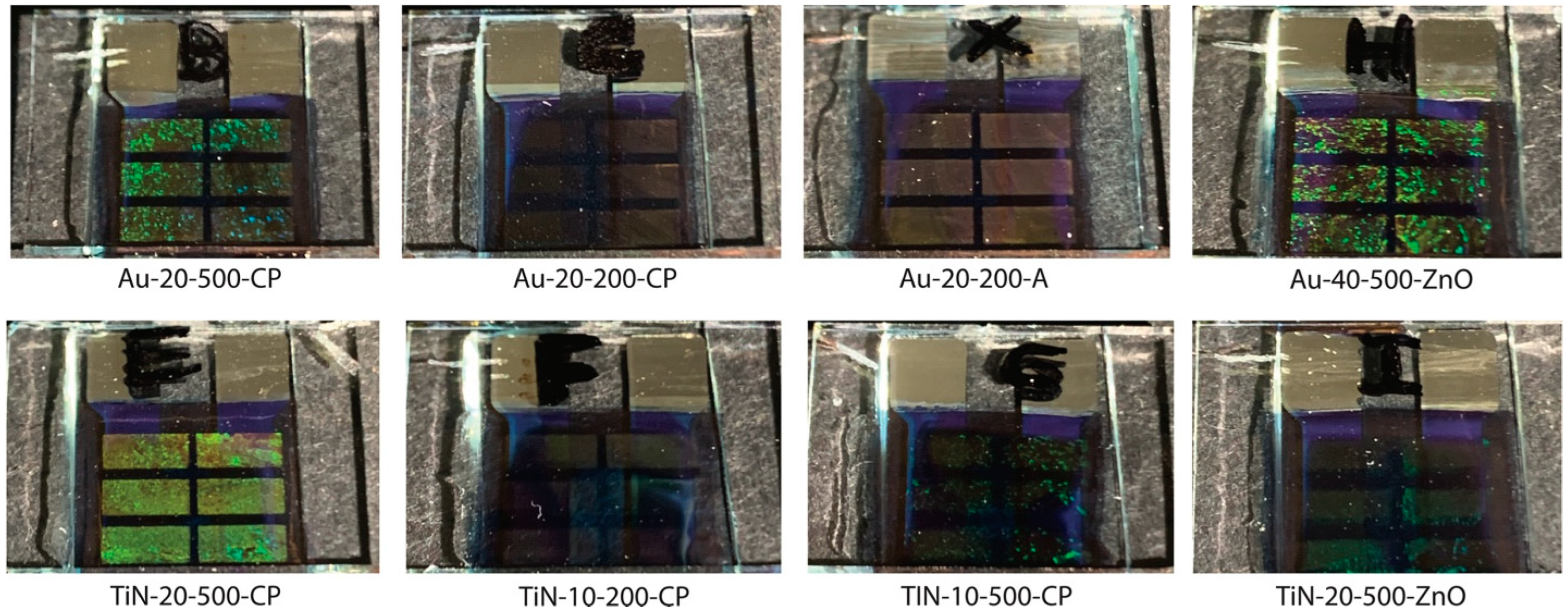


| Sample Code | Plasmonic Material | Thickness (nm) | NSL Bead Diameter (nm) | NSL Bead Packing | Substrate |
|---|---|---|---|---|---|
| Reference | - | - | - | - | ITO |
| Au-20-500-CP | Au | 20 | 500 | Close Packed | ITO |
| Au-20-200-CP | Au | 20 | 200 | Close Packed | ITO |
| Au-20-200-A | Au | 20 | 200 | Amorphous | ITO |
| TiN-20-500-CP | TiN | 20 | 500 | Close Packed | ITO |
| TiN-10-200-CP | TiN | 10 | 200 | Close Packed | ITO |
| TiN-10-500-CP | TiN | 10 | 500 | Close Packed | ITO |
| Au-40-500-ZnO | Au | 40 | 500 | Close Packed | ZnO |
| TiN-20-500-ZnO | TiN | 20 | 500 | Close Packed | ZnO |
| Sample Code | Jsc (mA/cm2) | Voc (mV) | Rs (Ω/cm2) | Rsh (Ω/cm2) | FF (%) | Champion Cell ηeff (%) | ηeff (%) | Enhancement (%) |
|---|---|---|---|---|---|---|---|---|
| Reference | 8.92 ± 0.74 | 861 ± 3 | 13.36 ± 0.75 | 1145 ± 290 | 59.9 ± 0.9 | 5.45 | 4.65 ± 0.46 | - |
| Au-20-500-CP | 9.51 ± 0.22 | 856 ± 9 | 11.57 ± 1.58 | 990 ± 298 | 56.5 ± 0.9 | 5.09 | 4.61 ± 0.34 | −0.8% |
| Au-20-200-CP | 8.79 ± 0.59 | 763 ± 9 | 22.83 ± 12.29 | 950 ± 773 | 48.7 ± 13.7 | 5.03 | 3.48 ± 1.55 | −25.1% |
| Au-20-200-A | 8.19 ± 0.19 | 861 ± 6 | 11.48 ± 0.50 | 1388 ± 313 | 62.6 ± 1.8 | 4.49 | 4.41 ± 0.07 | −5.1% |
| TiN-20-500-CP | 8.54 ± 0.16 | 853 ± 8 | 11.20 ± 0.21 | 1298 ± 275 | 60.5 ± 1.2 | 4.53 | 4.42 ± 0.08 | −4.9% |
| TiN-10-200-CP | 9.18 ± 0.15 | 852 ± 10 | 10.84 ± 1.74 | 1165 ± 292 | 61.0 ± 3.5 | 5.28 | 4.78 ± 0.35 | +2.8% |
| TiN-10-500-CP | 9.84 ± 0.49 | 862 ± 10 | 9.58 ± 1.00 | 1142 ± 181 | 61.4 ± 3.7 | 5.55 | 5.21 ± 0.37 | +12.0% |
| Au-40-500-ZnO | 8.58 ± 0.70 | 841 ± 11 | 12.66 ± 1.31 | 1548 ± 286 | 58.6 ± 0.9 | 4.73 | 4.23 ± 0.37 | −9.0% |
| TiN-20-500-ZnO | 10.24 ± 0.74 | 865 ± 7 | 11.39 ± 0.87 | 1127 ± 265 | 58.7 ± 1.7 | 5.56 | 5.20 ± 0.38 | +11.8% |
Disclaimer/Publisher’s Note: The statements, opinions and data contained in all publications are solely those of the individual author(s) and contributor(s) and not of MDPI and/or the editor(s). MDPI and/or the editor(s) disclaim responsibility for any injury to people or property resulting from any ideas, methods, instructions or products referred to in the content. |
© 2024 by the authors. Licensee MDPI, Basel, Switzerland. This article is an open access article distributed under the terms and conditions of the Creative Commons Attribution (CC BY) license (https://creativecommons.org/licenses/by/4.0/).
Share and Cite
Tütüncüoğlu, A.; Yüce, M.; Kurt, H. Titanium Nitride as an Alternative Plasmonic Material for Plasmonic Enhancement in Organic Photovoltaics. Crystals 2024, 14, 828. https://doi.org/10.3390/cryst14090828
Tütüncüoğlu A, Yüce M, Kurt H. Titanium Nitride as an Alternative Plasmonic Material for Plasmonic Enhancement in Organic Photovoltaics. Crystals. 2024; 14(9):828. https://doi.org/10.3390/cryst14090828
Chicago/Turabian StyleTütüncüoğlu, Atacan, Meral Yüce, and Hasan Kurt. 2024. "Titanium Nitride as an Alternative Plasmonic Material for Plasmonic Enhancement in Organic Photovoltaics" Crystals 14, no. 9: 828. https://doi.org/10.3390/cryst14090828
APA StyleTütüncüoğlu, A., Yüce, M., & Kurt, H. (2024). Titanium Nitride as an Alternative Plasmonic Material for Plasmonic Enhancement in Organic Photovoltaics. Crystals, 14(9), 828. https://doi.org/10.3390/cryst14090828







